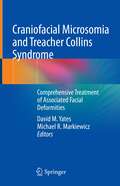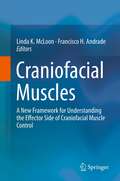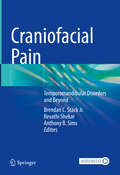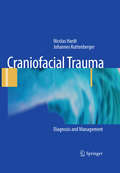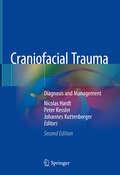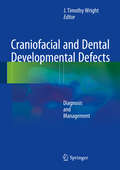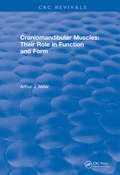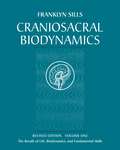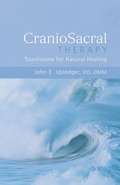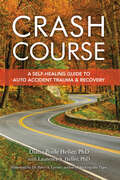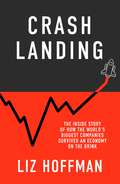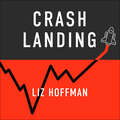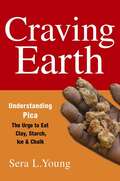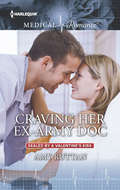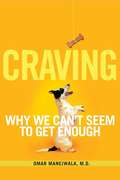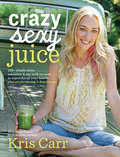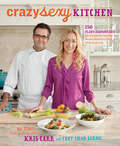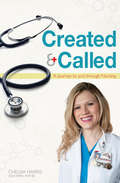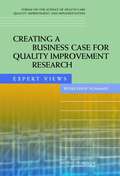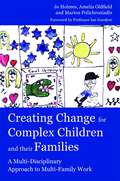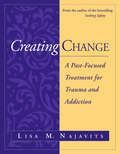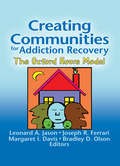- Table View
- List View
Craniofacial Microsomia and Treacher Collins Syndrome: Comprehensive Treatment of Associated Facial Deformities
by David M. Yates Michael R. MarkiewiczThe book provides a framework for diagnosis and treatment of the complex facial deformities found in craniofacial microsomia and Treacher Collins syndrome. These conditions are difficult to treat due to their complexity and variable presentation. The deformities may be mild or severe and merely cosmetic to life-threatening in nature. These conditions often manifest as complex facial deformities that require multiple surgical interventions. Timing is critical when treating these patients and knowing and choosing the correct operation is key to successful outcomes. This work provides a comprehensive approach in treating these complex patient populations, seeking to answer the following questions: When to operate versus when to wait? If operating is required what operation should be performed? What is the best orthodontic approach to the associated dental deformities that develop with these conditions? How should sleep apnea be evaluated and treated in this population? What is the best management for feeding patients with these conditions? Written by experts in the field, Craniofacial Microsomia and Treacher Collins Syndrome: Comprehensive Treatment of Associated Facial Deformities aims to provide the reader with literature based best practices in treating these children from the NICU through childhood and into adulthood.
Craniofacial Muscles: A New Framework for Understanding the Effector Side of Craniofacial Muscle Control
by Francisco Andrade Linda K. McloonOf the approximately 640 muscles in the human body, over 10% of them are found in the craniofacial region. The craniofacial muscles are involved in a number of crucial non-locomotor activities, and are critical to the most basic functions of life, including vision, taste, chewing and food manipulation, swallowing, respiration, speech, as well as regulating facial expression and controlling facial aperture patency. Despite their importance, the biology of these small skeletal muscles is relatively unexplored. Only recently have we begun to understand their unique embryonic development and the genes that control it and characteristic features that separate them from the skeletal muscle stereotype. This book is the most comprehensive reference to date on craniofacial muscle development, structure, function, and disease. It details the state-of-the-art basic science of the craniofacial muscles, and describes their unique response to major neuromuscular conditions. Most importantly, the text highlights how the craniofacial muscles are different from most skeletal muscles, and why they have been viewed as a distinct allotype. In addition, the text points to major gaps in our knowledge about these very important skeletal muscles and identified key gaps in our knowledge and areas primed for further study and discovery.
Craniofacial Pain: Temporomandibular Disorders and Beyond
by Brendan C. Stack Jr. Revathi Shekar Anthony B. SimsThis book provides a broad, evidence based resource for all clinicians who encounter challenging patients suffering from TMDs. Common causes of craniofacial and myofascial pain of the head and neck, TMD treatment paradigms, and associated symptoms are explained. Background information on TMJ Anatomy, TMD Epidemiology and Pathology is given and advanced topics like therapeutic target and movement disorders and TMD are discussed. All chapters follow a uniform outline and quality of material.This well-referenced book draws attention to the lack of appreciation and understanding of craniofacial pain diagnosis and intervention, and it equips readers to optimize basic treatment of patients with TMD.
Craniofacial Trauma: Diagnosis and Management
by Nicolas Hardt Johannes KuttenbergerThe book covers the entire scope of traumatology in the important border area between the neuro- and viscerocranium. It focuses on diagnostic operation planning and the interdisciplinary management of craniofacial injuries. In the first part, the classification and epidemiology of craniofacial fractures are outlined and specific problems are discussed. The second part deals with radiologic diagnostics and basic neurosurgical measures. The main part of the book covers operative principles and a step-by-step description of hard and soft tissue reconstruction after craniofacial trauma. Complications of craniofacial injuries and late reconstruction of craniofacial defects, including computer-assisted planning, are covered in the final part.
Craniofacial Trauma: Diagnosis and Management
by Nicolas Hardt Johannes Kuttenberger Peter KesslerThis book, now in a revised and updated second edition, offers detailed guidance on the diagnosis, surgical planning, and interdisciplinary treatment of craniofacial trauma. The first part of the book addresses epidemiology, anatomy, radiological diagnosis and innovations, fracture classification, fracture mechanisms, and symptoms. The second part then focuses on treatment, explaining operative principles and providing step-by-step descriptions of a variety of hard and soft tissue reconstructive procedures. Here, individual chapters are devoted to neurosurgical management, surgical repair of fractures, methods of dural and skull base treatment, osteosynthesis, intraoperative navigation techniques and systems, reconstruction with bone grafts and alloplastic materials, and complications and late sequelae. The book concludes by discussing surgical strategy in complex craniofacial trauma care and presenting a treatment algorithm that takes into account new developments. Craniofacial Trauma will be an indispensable reference for residents in maxillofacial training and for maxillofacial/neurosurgeons in the specialized field of craniofacial traumatology.
Craniofacial and Dental Developmental Defects: Diagnosis and Management
by J Timothy WrightThis book, now in an extensively revised second edition, describes the latest developments in planning, materials, provides the practitioner with a framework for establishing a diagnosis and developing a suitable treatment plan in patients presenting with a range of developmental defects of the teeth and the craniofacial complex. The conditions covered include failure of tooth eruption, hypodontia, premature tooth exfoliation, defects of enamel development, and defects of dentin development, with full consideration of both syndromic and non-syndromic defects, including facial clefting. In each case the phenotype and genotype are first described, followed by diagnostic information, including the availability of genetic testing, and treatment options. Summarizing tables highlight the key diagnostic features, and helpful illustrated case presentations are included. Cleft palate is addressed, with details on etiology, phenotypes, treatment timing and approaches, and dental management. The closing chapter provides stimulating reflections on potential future directions in the diagnosis and treatment of these disorders.
Craniofacial and Dental Developmental Defects: Diagnosis and Management
by J. Timothy WrightThis book provides the practitioner with a framework for establishing a diagnosis and developing a suitable treatment plan in patients presenting with a range of developmental defects of the teeth. The conditions covered include failure of tooth eruption, hypodontia, premature tooth exfoliation, defects of enamel development, and defects of dentin development, with full consideration of both syndromic and non-syndromic defects. In each case the phenotype and genotype are first described, followed by diagnostic information, including the availability of genetic testing, and treatment options. Summarizing tables are used to highlight the key diagnostic features, and helpful illustrated case presentations are included. Cleft palate is also addressed, with details on etiology, phenotypes, treatment timing and approaches, and dental management. The closing chapter provides stimulating reflections on potential future directions in the diagnosis and treatment of these disorders.
Craniomandibular Muscles: Their Role in Function and Form (CRC Press Revivals)
by Arthur J. MillerThis book provides a comprehensive scientific investigation into every aspect of craniomandibular muscle function in both human and experimental animal studies. Topics discussed cover three broad areas: the anatomical, physiological, and histochemical aspects of these muscles; the special importance of these muscles to resting mandibular posture and mastication; and their role in clinically relevant problems involved with occlusion, craniomandibular disorders, and the growth and development of the cranioskeleton. Over 150 figures and tables are used to illustrate the concepts in these three areas. Methods for studying craniomandibular muscles are examined in depth, and the use of classically defined techniques such as electromyography and newer approaches using magnetic resonance spectroscopy and immunological identification of contractile proteins are discussed. Specialists in oral biology, orthodontics, oral surgery, prosthodontics, and craniomandibular disorders in schools and in private practice should consider this book an indispensable resource for their work and studies.
Craniomaxillofacial Reconstructive and Corrective Bone Surgery: Principles Of Internal Fixation Using Ao/asif Technique
by Alex M. Greenberg Rainer SchmelzeisenThis in-depth revision of the successful first edition is one of the only books of its kind to cover the full range of craniomaxillofacial reconstructive and corrective bone surgery. This evolving field has a large number of contributions by worldwide clinicians covering new developments, especially in biomaterials, digital technologies, virtual surgical planning, patient specific implants, and navigation. These topics appeal to Oral and Maxillofacial Surgeons, Plastic Surgeons, ENT/Head and Neck Surgeons, and Neurosurgeons. Complete with updates on popular topics from the first edition, such as advanced jaw reconstruction with stem cells and tissue engineering, wide varieties of microvascular flaps, orthognathic surgery, endoscopic skull base surgery, dental implantology, craniofacial surgery and facial allotransplantation.
Craniosacral Biodynamics, Volume One
by Franklyn Sills Dominique DegrangesCraniosacral therapy is based on the belief that functions of the human system are maintained and integrated by a biodynamic force known as 'primary respiration,' or the breath of life. Found in the brain, spinal cord, and bodily fluids, this rhythmic pulse promotes healing and health. Written for students and practitioners but accessible to lay readers, this text presents the fundamental concepts and techniques of a method that redirects the cerebrospinal fluid to areas of imbalance, thus enhancing overall health. Volume One covers both the history and conceptual ideas fundamental to Craniosacral Biodynamics, as well as the more complex structural and tissue relationships.
Craniosacral Therapy: Touchstone for Natural Healing
by John E. UpledgerThe book recounts author's development of CranioSacral Therapy. John E. Upledger shares poignant case studies of restored health: a five-year-old autistic boy, a man with Erbs palsy, a woman with a fifteen year history of severe headaches, and numerous others. And he offers simple CranioSacral Therapy techniques you can perform at home on yourself or loved ones.
Crash Course: A Self-Healing Guide to Auto Accident Trauma and Recovery
by Diane Poole Heller Laurence S. HellerTrauma following automobile accidents can persist for weeks, months, or longer. Symptoms include nervousness, sleep disorders, loss of appetite, and sexual dysfunction. In Crash Course, Diane Poole Heller and Laurence Heller take readers through a series of case histories and exercises to explain and treat the health problems and trauma brought on by car accidents.
Crash Landing: The Inside Story Of How The World's Biggest Companies Survived An Economy On The Brink
by Liz HoffmanIt was the ultimate test for CEOs, and almost none of them saw it coming.__________In early March 2020, with the Dow Jones flirting with 30,000, the world's biggest companies were riding an eleven-year economic high. By the end of the month, millions would be out of work, iconic firms were begging for bailouts, and countless small businesses were in freefall. Slick consulting teams and country-club connections were suddenly of little use: business leaders were fumbling in the dark, tossing out long-term strategy and making decisions on the fly-decisions, they hoped, that might just save them.In Crash Landing, award-winning business journalist Liz Hoffman shows how the pandemic set the economy on fire-but if you look closely, the tinder was already there.Based on astonishing access inside some of the world's biggest and most iconic companies, this is a gripping account of the most remarkable period in modern economic history, revealing how they battled against an economic catastrophe for which there was no playbook: among them, AirBnB's Brian Chesky, blindsided by a virus in the middle of a high-stakes effort to go public; American Airlines's Doug Parker, shuttling between K Street and the White House, determined to secure a multi-billion-dollar bailout; and Ford's Jim Hackett, as his assembly lines went from churning out cars to ventilators.Crash Landing reveals the fear, grit, and gambles of the pandemic economy, while probing its implications for the future of work, corporate leadership, and capitalism itself, asking: Will this remarkable time give rise to newfound resilience, or become just anothercostly mistake to be forgotten?__________A gripping account of the financial carnage of the pandemic, revealing the fear, grit, and gambles that drove the economy's winners and losers.
Crash Landing: The Inside Story Of How The World's Biggest Companies Survived An Economy On The Brink
by Liz HoffmanAn exposé of the billionaires who built the US economy on sand, and the virus that saw it crumble.A kaleidoscopic account of the financial carnage of the pandemic, revealing the fear, grit, and gambles that drove the economy's winners and losers-from a leading Wall Street Journal reporter.Crash Landing takes readers behind the scenes of an unprecedented period of global economic turmoil, letting readers into the inner lives of the men and women trying to save big business from the brink.The world's most powerful CEOs never saw it coming, especially after a decade of growth that saw them riding high. Then whispers of a new flu-like illness became a crescendo, and by the end of March 2020 ten million people were out of work, iconic firms were begging for bailouts, and countless small businesses were in freefall.How do you sustain a workforce that can no longer work? How do you ride out a crisis that has no end in sight? How do you prepare for a recovery in a new world? Liz Hoffman pulls back the curtain on the most violent few months in the modern global economy, taking readers inside boardrooms, onto factory floors and into trading pits. Featuring original interviews with the people responsible for the economy, and in charge of making sure it survives. A gripping story of big business and even bigger characters, Crash Landing will appeal to fans of Michael Lewis and Andrew Sorkin. This is an audiobook that gives you the inside scoop, and answers the most important question of today: Will this remarkable time give rise to newfound resilience, or become just another costly mistake to be forgotten?(P) 2022 Hodder & Stoughton Limited
Craving Earth
by Sera YoungHumans have eaten earth, on purpose, for more than 2,300 years. They also crave starch, ice, chalk, and other unorthodox items of food. Some even claim they are addicted and "go crazy" without these items, but why?Sifting through extensive historical, ethnographic, and biomedical findings, Sera Young creates a portrait of pica, or nonfood cravings, from humans' earliest ingestions to current trends and practices. In engaging detail, she describes the substances most frequently consumed and the many methods (including the Internet) used to obtain them. She reveals how pica is remarkably prevalent (it occurs in nearly every human culture and throughout the animal kingdom), identifies its most avid partakers (pregnant women and young children), and describes the potentially healthful and harmful effects. She evaluates the many hypotheses about the causes of pica, from the fantastical to the scientific, including hunger, nutritional deficiencies, and protective capacities. Never has a book examined pica so thoroughly or accessibly, merging absorbing history with intimate case studies to illuminate an enigmatic behavior deeply entwined with human biology and culture.
Craving Earth: Understanding Pica—the Urge to Eat Clay, Starch, Ice, and Chalk
by Sera YoungHumans have eaten earth, on purpose, for more than 2,300 years. They also crave starch, ice, chalk, and other unorthodox items of food. Some even claim they are addicted and "go crazy" without these items, but why?Sifting through extensive historical, ethnographic, and biomedical findings, Sera L. Young creates a portrait of pica, or nonfood cravings, from humans' earliest ingestions to current trends and practices. In engaging detail, she describes the substances most frequently consumed and the many methods (including the Internet) used to obtain them. She reveals how pica is remarkably prevalent (it occurs in nearly every human culture and throughout the animal kingdom), identifies its most avid partakers (pregnant women and young children), and describes the potentially healthful and harmful effects. She evaluates the many hypotheses about the causes of pica, from the fantastical to the scientific, including hunger, nutritional deficiencies, and protective capacities. Never has a book examined pica so thoroughly or accessibly, merging absorbing history with intimate case studies to illuminate an enigmatic behavior deeply entwined with human biology and culture.
Craving Her Ex-Army Doc
by Amy RuttanFlirting with danger... Having sworn off love when his wife left him for his best friend, ex-army doc Luke Ralston revels in his lone wolf existence. Until the arrival of beautiful doctor Sarah Ledet tempts him to reconsider his stance on romance. Sexy Luke is the last kind of distraction Sarah needs as she starts over, determined to prove herself once and for all. But when an avalanche traps them together, and body heat is the only way to survive, suddenly all bets are off!
Craving: Why We Can't Seem to Get Enough
by Omar ManejwalaA nationally recognized expert on compulsive behaviors explains the phenomenon of craving and gives us tools to achieve freedom from our seemingly insatiable desires by changing our actions to remap our brains.When we find ourselves wanting something strong enough, we’ll do just about anything to get it--sometimes at the expense of our bodies, brains, bank accounts, and relationships. So why do we sometimes have the irrepressible feeling that we need something--such as food, cigarettes, alcohol, or sex--that we really just want? And how do we satiate that feeling without indulging it?In Craving, Omar Manejwala, M.D., translates the neurobiology of this phenomenon into real and accessible terms, explaining why we just can’t seem to get enough. He then gives us tools and guidance to find satisfaction without giving in to our cravings. Dr. Manejwala explains:how and why our brain drives behaviorhow to change the part of our brain that fuels our cravingsthe warning signs that craving is evolving into addictionwhy craving is the most difficult component of addiction to addresswhy self-help and spiritual groups that use models like the Twelve Steps are so effective at changing behaviors, receiving encouragement, and remaining accountable.
Crazy Sexy Juice: 100+ Simple Juice, Smoothie & Nut Milk Recipes To Supercharge Your Health
by Kris CarrWelcome to a juicing and blending adventure! If you’ve picked up this book, it’s likely that you’re looking to bring more zing into your life. Perhaps you’re feeling a little tired. Bloated. Out of sorts. Whatever it is, you’ve come to the right place. Get ready to say good-bye to feeling meh and hello to feeling fabulous! In Crazy Sexy Juice, wellness advocate and New York Times best-selling author Kris Carr teaches you everything you need to know about creating fresh, nutritious juices and smoothies, and creamy, indulgent nut and seed milks. With enough recipes to keep your juicer and blender humming through every season, she shows you how to fit them into your life, helping you make health deposits—instead of withdrawals! Cha-ching! She guides you through her wonderful world by teaching you: How to create flavor combinations that tantalize your taste buds How to choose the best juicer, blender, and kitchen tools Ways to save money while prioritizing fresh, organic produce Troubleshooting advice for common kitchen mishaps Tips for selection, storage, and preparation of ingredients Answers to frequently asked questions and health concerns Suggestions for juicing and blending on the go Tips on how to get your family onboard and make this lifestyle stick And oh, so much more… Whether you’re an old pro at making liquid magic or just starting out, Kris will help you experience juicing and blending as a fun and delicious journey into the transformative powers of fruits and veggies! By simply adding these nutrient-dense beverages to your daily life, you can take control of your health—one sip at a time. With more than 100 scrumptious recipes and oodles of information, you’ll be ready to dive into a juicing paradise. Cheers to that! Includes an easy and energizing 3-day cleanse!
Crazy Sexy Kitchen: 150 Plant-empowered Recipes To Ignite A Mouthwatering Revolution
by Kris Carr Chef Chand SarnoVeggie Manifesto for plant-empowered gourmands and novices alike, and it's filled with inspiration, education, cooking tips, and over 150 nourishing, nosh-worthy recipes. Infused with her signature humor, style, and personal stories, Crazy Sexy Kitchen redefines the kitchen as headquarters for America's wellness revolution. The goodness born in the Crazy Sexy Kitchen will reach deep into the rest of your life-enriching your health, your home, your heart, and the planet. Crazy Sexy Kitchen gives readers all the tools and know-how needed to adopt a joyful and vibrant Crazy Sexy Diet and Lifestyle. What is the Crazy Sexy Diet and Lifestyle, you ask? A nutrient-dense, plant-happy approach to eating and living that harmonizes your beautiful body at the cellular level. It's a celebratory way of life that's deeply connected, healthy, awake and engaged. Now that's SEXY! Like a long, luxurious meal, Crazy Sexy Kitchen is laid out in courses. You'll start with a detailed review of the Crazy Sexy Diet. Next you'll learn how to stock your culinary arsenal. Kris will show you how to find the best kitchen tools and equipment, and prep you with basic culinary skills and lingo. Handy symbols like, gluten-free, soy-free, kid-friendly-and for the time pressed-Crazy Sexy Quickies, help you to easily identify the recipes that are perfect for your dietary needs. Not sure how to put a whole meal together? No problem. Crazy Sexy Kitchen covers that, too-with a hearty dose of menu plans and recipes to inspire and delight. Joined by Whole Foods chef, Chad Sarno, Crazy Sexy Kitchen offers over 150 delicious, nutrient-dense recipes designed to nourish the mind, body, and soul. From juicing to planning a three-course meal, Crazy Sexy Kitchen has all the essentials to fill your kitchen (and life!) with health, happiness, family, friends, and good times.
Created & Called
by Chelsia HarrisHave you ever wondered: "What are my gifts? What exactly is God calling me to do with my life?" Although the profession of nursing can provide a comfortable income, it is more than just a salary. Eternal rewards are reflected when a nurse aids in the alleviation of a patient's pain, leads a dying patient in a prayer of salvation, or has the opportunity to assist in the welcoming of a new life into this world. I challenge you to keep your heart and mind open to this possibility for your life as you: Discover the physical, emotional, and spiritual sacrifice of nurses, and how a nurse can offer himself or herself in service to aid patients in vulnerable states of life Read real life examples of sound nursing in action and the amazing impact you can have on patients and their families Learn the differences between a Licensed Practical Nurse (LPN), Associate Degree in Nursing (ADN), Bachelor of Science in Nursing (BSN), Master of Science in Nursing (MSN), and more! It is my prayer that as you read this book, you will search your heart, cultivate a deeper, more intimate relationship with Jesus Christ, and close the book knowing whether God is calling you to this incredible, humbling profession called nursing. Never forget we can do all things through Christ who strengthens us.
Creating A Business Case For Quality Improvement Research: Expert Views
by Institute of Medicine of the National AcademiesCreating a Business Case for Quality Improvement Research focuses on issues related to improving the science supporting health care quality and eliminating communication barriers that prevent advances in the field. In 2007, the Institute of Medicine convened a workshop designed to identify the economic and business disciplines that encourage sustained efforts to improve the quality of health care. Workshop presenters and participants included representatives from academia, government and industry. A business case for quality improvement depends heavily on the progress made in the following areas: systems change and leadership, data transparency, funding, enhanced training programs and ongoing dialogue between industry officials, patients and their families. They identified a major barrier to these efforts as the nationwide institutional reluctance to invest in quality improvement and documentation of outcomes, due largely to limited resources and competing priorities as to how these resources are spent in the industry. Too often priorities are placed on creating highly-visible technology-driven programs, with less emphasis in meeting the needs and expectations of the patients. In Creating a Business Case for Quality Improvement Research, a diverse group of stakeholders identifies and assesses these and other challenges to attain a better understanding of how to create a high-value health care system for the general population.
Creating Change for Complex Children and their Families: A Multi-Disciplinary Approach to Multi-Family Work
by Amelia Oldfield Marion Polichroniadis Jo Holmes Ian M GoodyerThe strain of caring for children struggling with severe and complex mental health needs affects the entire family. The staff at the innovative Croft Child and Family Unit have developed a unique approach of working intensively with the whole family, and encouraging them to share their experiences with other families, to instigate a complete change that will benefit all family members. Using detailed case studies to illustrate the model, the book focuses on the needs of children with a wide range of developmental, emotional and behavioural difficulties, and explores the complicated interactions between these children, their families and their communities. The care team includes nurses, psychiatrists, doctors, family therapists and creative therapists, social workers and teachers. They examine how to integrate a range of therapeutic interventions and how to use the powerful relationships that develop between professionals and families to enable positive, lasting changes. This book will be indispensable reading for trainees and professionals working with children with mental health problems and their families, and special needs educationalists wanting to understand the benefits of an intensive, multi-family approach to treatment for children who do not respond to standard community interventions.
Creating Change: A Past-Focused Treatment for Trauma and Addiction
by Lisa M. NajavitsThis flexible, evidence-based manual offers counselors a gentle, compassionate approach to help people with trauma, addiction, or both explore their past. Creating Change guides clients to understand how trauma and addiction arose over time, grieve losses and regrets, create a new perspective on their life story, and take pride in their survival. The manual has 23 topics that can be implemented in any order with individuals or groups. Topics include Relationship Patterns, Break the Silence, Deepen Your Story, Darkness and Light, Emotions and Healing, and Influences: Family, Community, Culture. Creating Change can be implemented with any other treatment, including the author&’s present-focused model, Seeking Safety. The book has a convenient large-size format and includes 70 reproducible handouts, many of which can be downloaded and printed at the companion website. See also Seeking Safety: A Treatment Manual for PTSD and Substance Abuse, and the self-help guide Finding Your Best Self, Revised Edition: Recovery from Addiction, Trauma, or Both, an ideal client recommendation.
Creating Communities for Addiction Recovery: The Oxford House Model
by Leonard A. Jason Bradley D. Olson Joseph R. Ferrari Margaret I. DavisLearn to create a positive research/action alliance similar to that of DePaul University and the Oxford House communityThis book reviews important research conducted in a 13-year collaborative partnership between Oxford House (a community-based, self-run residential substance abuse recovery program) and DePaul University. It also presents practical guidelines for developing effective action research collaborative programs that can cultivate and maintain mutually beneficial community/research partnerships.Creating Communities for Addiction Recovery: The Oxford House Model presents and examines: practical guidelines for developing effective action research collaboratives focusing on the development of trust, respecting the personal experiences of the community members and the group, commitment to serving the community, validating findings with organization members, and accountability the experiences and attitudes of Oxford House community members in light of their participation in the collaborative research projects described in the book the essentials of designing and creating an efficient and productive yet homey residential community environment for addicted persons the factors that make Oxford Houses in the United States and Australia "safe and sober" settings for persons in recovery the differential growth among self-governed substance abuse recovery homes for men and for women-with a focus on the impact of state loan programs and the utilization of technical assistance in relation to the expansion of women&’s houses as compared with men&’s the economic advantages of the Oxford House model as compared with other treatment and incarceration alternatives the roles of ethnicity and gender in substance abuse recovery the structural social support of Oxford House men-and the impact of parenthood on these men&’s substance use patterns and recovery attempts the medical care (need and utilization) patterns of a substance abusing and recovering population how Oxford House&’s African-American community functions as a source of abstinent social networks the sense of community among women and women with children living in Oxford Houses-with emphasis on how the presence of children impacts the household perspectives of leadership by women (some with children, some without) affiliated with Oxford HousesThe information in this book shows that the rules of the game have changed. Substance abusers now can take charge of their own recovery in effective and efficient ways, and practitioners can find low-cost housing options for their clients with substance abuse problems. As a part of your professional/teaching collection, Creating Communities for Addiction Recovery can help you or your students take understand and make effective use of this rapidly evolving paradigm of community-based recovery.
